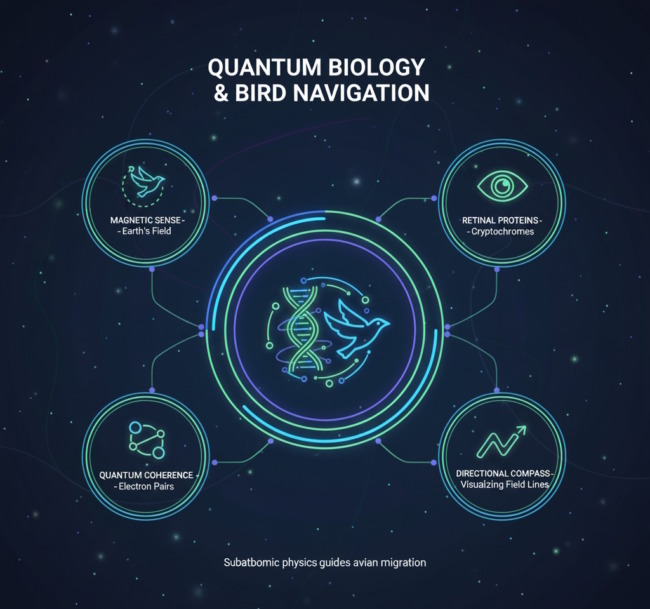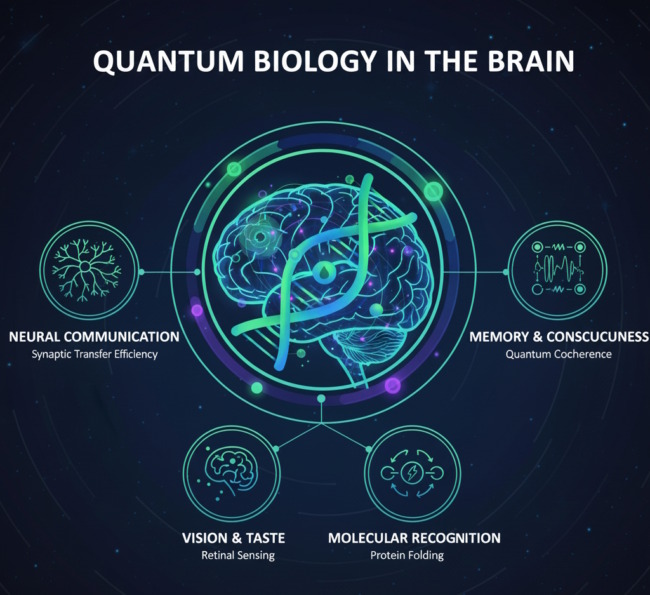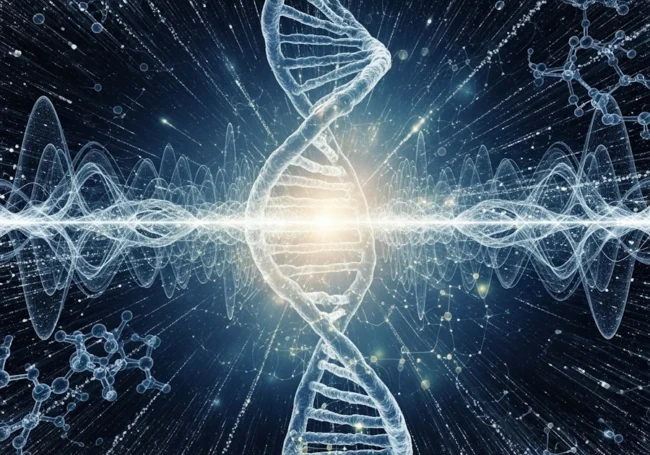The robin outside your window navigates thousands of miles with pinpoint accuracy, somehow knowing exactly which direction is north. Plants around you capture sunlight so efficiently that our most advanced solar panels look primitive by comparison. The explanation for these everyday miracles involves some of the strangest phenomena in physics happening right inside living creatures, including you.
Where physics meets life
Let’s start with the basics. Quantum mechanics is the branch of physics that describes how tiny particles like electrons and atoms behave. At this microscopic scale, things get weird – really weird. Particles can be in multiple places at once, they can “tunnel” through barriers that should be impossible to cross, and they can be mysteriously connected across vast distances.
For decades, scientists assumed these quantum effects were too delicate to survive in the warm, wet, noisy environment of living cells. It’s like trying to hear a whisper at a rock concert – the biological “noise” should drown out any quantum “whispers.” But here’s where it gets incredible: life doesn’t just tolerate quantum effects, it actually uses them as sophisticated tools.
Your inner quantum compass
Let’s talk about that robin we mentioned. How does it navigate thousands of miles with pinpoint accuracy? The answer lies in a quantum compass built right into its eyes.
Inside the robin’s retina are special proteins called cryptochromes. When light hits these proteins, it creates pairs of electrons that are “quantum entangled” – meaning they’re connected in a way that Einstein famously called “spooky action at a distance.” These entangled electrons are sensitive to Earth’s magnetic field in a way that classical physics can’t explain.

Think of it like having a built-in GPS that works on quantum principles. The bird literally sees the magnetic field as patterns of light and dark overlaid on its normal vision. It’s as if the robin is wearing quantum goggles that show it invisible highways in the sky.
And here’s the kicker – you probably have the same proteins in your eyes. Scientists are still investigating whether humans might have some vestigial magnetic sensing ability too.
The quantum solar panel in every leaf
Now let’s shrink down even smaller and look at something happening in plants around you right now. Photosynthesis – the process that turns sunlight into energy – is one of the most efficient energy conversion systems on Earth. A typical plant captures and converts about 95% of the light energy it absorbs, while our best artificial solar panels struggle to reach 25% efficiency.
How do plants do it? Quantum mechanics, of course.
When a photon of light hits a chlorophyll molecule in a leaf, it creates what’s called an “exciton” – basically a packet of energy that needs to travel to the reaction center where photosynthesis happens. Here’s where it gets quantum: this energy doesn’t just take one path like you might expect. Instead, it takes all possible paths simultaneously, thanks to a quantum effect called superposition.
Imagine you’re trying to find the fastest route through a maze. Classical physics would say you have to try one path at a time. But quantum mechanics allows the energy to explore every possible route at once, then “choose” the most efficient one. It’s like having a GPS that calculates all possible routes instantly and always picks the perfect one.
This quantum “coherence” lasts for surprisingly long times in the plant – much longer than scientists thought possible in such a warm, chaotic environment. It’s as if nature has figured out how to maintain quantum effects even in the biological equivalent of that rock concert we mentioned earlier.
Deep inside the eyes of migrating birds lies one of nature’s most sophisticated navigation systems, and it operates on principles that would make a quantum physicist marvel. European robins, along with many other migratory species, possess specialized proteins called cryptochromes in their retinas that function as biological quantum compasses.

These proteins contain pairs of electrons that become “quantum entangled” when struck by blue light, creating what scientists call radical pairs. The Earth’s magnetic field influences how these entangled electrons behave, causing them to exist in different quantum states depending on the bird’s orientation relative to magnetic north.
What makes this phenomenon truly remarkable is that the bird can literally see the magnetic field as patterns of light and shadow overlaid on its normal vision. Imagine having a heads-up display showing magnetic field lines superimposed on everything you look at – that’s essentially what these birds experience.
The quantum entanglement between the electron pairs is incredibly delicate, lasting only microseconds before environmental noise destroys the quantum coherence. Yet somehow, evolution has fine-tuned this system to work reliably across thousands of miles of migration routes.
Recent experiments have shown that disrupting the quantum states in these cryptochromes with radio waves can actually disorient birds, proving that this isn’t just theoretical physics but a practical navigation tool refined over millions of years. The most mind-bending aspect is that these quantum effects, which we typically associate with ultra-cold laboratory conditions, are happening at body temperature inside a living, breathing animal. The bird’s eye has essentially evolved into a room-temperature quantum sensor more sensitive than anything we’ve managed to build in our labs.
Scientists are now studying how biological systems maintain quantum coherence in warm, noisy environments – knowledge that could revolutionize quantum computing and sensing technologies. The European robin, it turns out, has been carrying around quantum technology in its head long before humans even knew quantum mechanics existed.
The quantum nose: smelling in multiple dimensions
Here’s something that might change how you think about your morning coffee. The way you smell that rich aroma might involve quantum mechanics too.
Your nose contains about 400 different types of odor receptors, and for years, scientists thought smell worked like a lock-and-key system – molecules with the right shape fit into the right receptors. But this couldn’t explain everything. Why do some molecules with very similar shapes smell completely different? Why do some molecules with different shapes smell the same?
Enter the quantum theory of smell. Some scientists propose that your nose doesn’t just detect the shape of odor molecules, but also their quantum vibrations. Each molecule has a unique vibrational “fingerprint” based on how its atoms are connected and how they move. Your odor receptors might be detecting these quantum vibrations, giving you a much more sophisticated sense of smell than anyone previously imagined.
When you smell that coffee, you might be detecting the quantum symphony of hundreds of different molecules, each playing their own vibrational tune. Your brain then interprets this quantum orchestra as the complex, rich scent you know and love.
Quantum effects in your brain
Speaking of your brain, quantum biology might be happening between your ears too. Some researchers propose that quantum effects could help explain one of the biggest mysteries in science: consciousness itself.

Microtubules – tiny structures inside your brain cells – might be acting like quantum computers, processing information in ways that classical physics can’t explain. This is still highly speculative and hotly debated, but imagine if your thoughts and consciousness emerge from quantum processes happening in billions of brain cells.
It would mean that every time you have a thought, make a decision, or remember something, you’re using the same strange quantum effects that help birds navigate and plants harvest sunlight. You’d literally be a quantum computer made of flesh and blood.
Quantum biology and enzymes in the body
Let’s zoom in on something happening in your body right now. Enzymes – the proteins that make chemical reactions happen in your cells – work with incredible efficiency. Some enzymes can catalyze millions of reactions per second, and they rarely make mistakes.
How do they do it? Many enzymes use quantum tunneling, a process where particles can pass through energy barriers that should be impossible to cross classically. It’s like having a ball that can magically pass through a wall instead of having to go over it.
In your digestive system, enzymes use quantum tunneling to break down food molecules. In your muscles, other enzymes use it to produce the energy you need to move. Even the enzyme that copies your DNA when cells divide relies on quantum tunneling to work accurately.
Without quantum biology, you literally wouldn’t be able to digest your lunch or walk across the room.
The quantum future of medicine
Understanding quantum biology isn’t just intellectually fascinating – it could revolutionize medicine. If diseases disrupt the quantum processes in our cells, then quantum-based treatments might be incredibly precise and effective.
Imagine cancer drugs that use quantum effects to target only tumor cells, leaving healthy cells untouched. Or antidepressants designed around the quantum processes in brain cells, with fewer side effects and better results. Some researchers are even exploring whether we could use quantum biology to enhance human capabilities – better night vision, magnetic sensing, or more efficient metabolism.
The big picture
You might be thinking, “This is all fascinating, but why should I care?” Here’s why: quantum biology is changing our understanding of life itself. We’re discovering that the boundary between physics and biology isn’t as clear as we once thought. Life doesn’t just follow the laws of physics – it exploits them in ways we’re only beginning to understand.
Every breath you take, every heartbeat, every thought you think might involve quantum effects that we’re just starting to discover. You’re not just a collection of chemicals following classical physics – you’re a quantum being, using some of the strangest phenomena in the universe to navigate, think, and live.
Quantum biology is still a young field, and many of its claims are still being tested and debated. But what’s already clear is that life has been using quantum mechanics for billions of years, long before humans discovered these effects in physics labs.
Evolution has had eons to experiment with quantum effects, and the results are all around us – in the efficiency of photosynthesis, the precision of bird migration, the speed of enzyme reactions, and possibly even in the mystery of consciousness itself.
Sources
- Al-Khalili, J. & McFadden, J. (2014) Life on the Edge: The Coming of Age of Quantum Biology. London: Bantam Press.
- Ball, P. (2011) ‘Physics of life: The dawn of quantum biology’, Nature, 474(7351), pp. 272–274.
- Ritz, T., Adem, S. & Schulten, K. (2000) ‘A model for photoreceptor-based magnetoreception in birds’, Biophysical Journal, 78(2), pp. 707–718.
- Lambert, N., Chen, Y.N., Cheng, Y.C., et al. (2013) ‘Quantum biology’, Nature Physics, 9, pp. 10–18.
- Mohseni, M., Omar, Y., Engel, G. & Plenio, M.B. (eds.) (2014) Quantum Effects in Biology. Cambridge: Cambridge University Press.
- Jones, R.S. & Hore, P.J. (2010) ‘Quantum mechanics in biology: Bird navigation and the quantum compass’, Proceedings of the Royal Society A, 466, pp. 2101–2122.
- Turin, L. (1996) ‘A spectroscopic mechanism for primary olfactory reception’, Chemical Senses, 21(6), pp. 773–791.
- Hameroff, S. & Penrose, R. (2014) ‘Consciousness in the universe: A review of the “Orch OR” theory’, Physics of Life Reviews, 11, pp. 39–78.

Leave a Reply